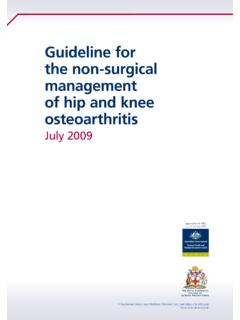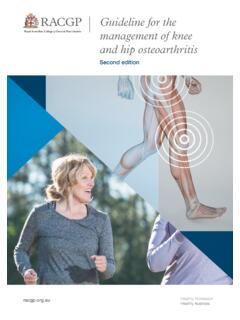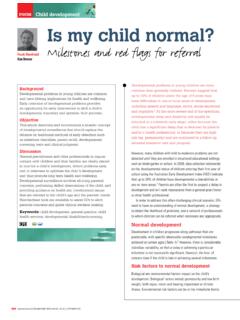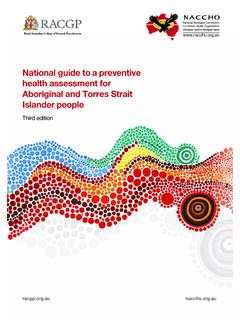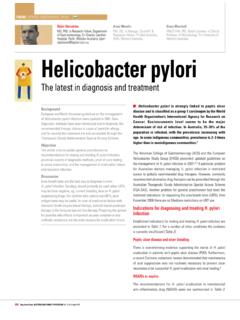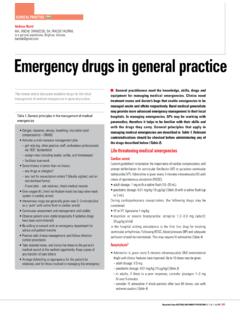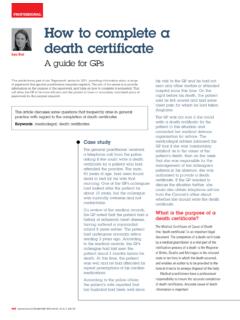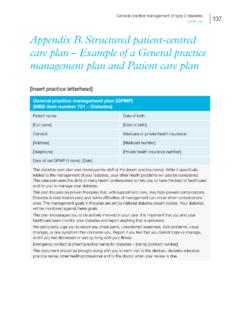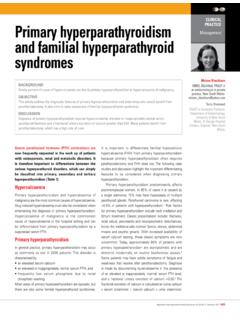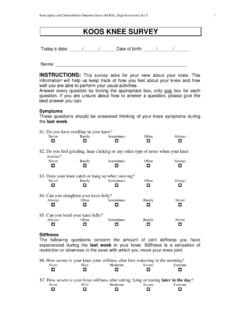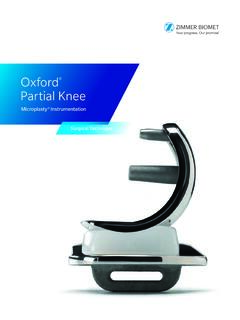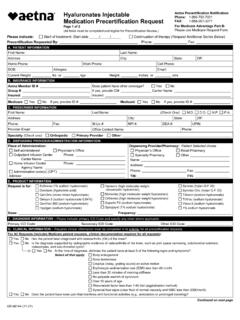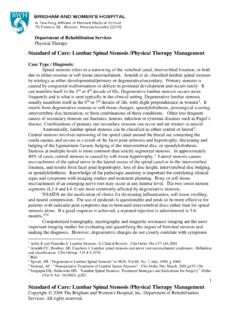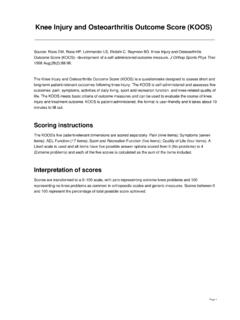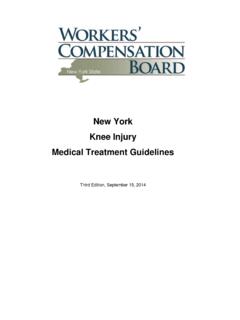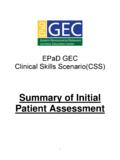Transcription of RACGP - Knee strengthening exercises
1 HANDIM aking non-drug interventions easier to find and published: October 2014. Reprinted with permission from The Royal Australian College of General Practitioners, October of strengthening exercises for knee osteoarthritisThis strengthening exercise program includes exercises that have been shown to be beneficial for people with knee osteoarthritis . The exercises aim to improve the strength of certain muscles that will provide better support for the knee during walking and other tasks. Stronger muscles help to cushion as well as support and protect the joint. Stronger muscles also make it easier to perform many daily activities, such as standing up from a are points to remember when doing strengthening exercises : Do all your exercises at least 3 times a week.
2 To get stronger, you need to feel like the exercise was hard or very hard when you did it. If it felt easy , you may not be gaining you experience difficulty performing any exercise, talk to your health professional on your next visit so that the exercise can be reviewed and modified if necessary. Sometimes it takes a bit of trial and error to get the right set of exercises for should progress to the next stage when knee exercises feel easy .SafetyBe safe when doing your home exercises ! If you are standing to do an exercise, use a chair or bench for support, or have one close, just in case you lose your balance. Move carefully and at a medium speed.
3 Try to avoid sudden or jerky movement. Consider your footwear. Is it appropriate for what you are doing? Choose shoes that will not make your feet sore or give you blisters. Make sure your shoes will not make you trip or lose increase the resistance of the home exercises , adjustable ankle weights or elastic exercise bands can be used. The elastic bands are available in a variety of brands, such as Theraband , and come in different resistances. Ankle weights and resistance band can be purchased at most sporting equipment stores or your local physiotherapy or medical clinic. Talk to your healthcare professional for advice about what level to start some discomfort or pain during exercise is normal; however, revise the exercise dosage if: the pain is excessive the pain remains elevated for more than 2 hours after exercise there is increased joint swelling the next strengthening exercisesHANDIM aking non-drug interventions easier to find and published: October 2014.
4 Reprinted with permission from The Royal Australian College of General Practitioners, October StartedInner range quads over roll with resistanceThis strengthening exercise program includes exercises that have been shown to be beneficial for people with knee osteoarthritis . The exercises aim to improve the strength of certain muscles that will provide better support for the knee during walking and other tasks. Stronger muscles help to cushion as well as support and protect the joint. Stronger muscles also make it easier to perform many daily activities, such as standing up from a positionStarting positionSit on a firm surface with body weight supported by arms behind.
5 Alternatively, you can lie down if you prefer. Support the affected knee on a rolled up towel. Your affected knee should be bent about 30 (or 1/3 bent).Keep the knee cap and toes pointing toward the the knee in contact with the towel, straighten the affected leg and SLOWLY lift the heel off the surface over 2 the leg as straight as it will go for 5 seconds then SLOWLY lower down over 2 seconds. Hold the leg as straight as it will go for 5 seconds then SLOWLY lower down over 2 seconds. Slowly up, hold, 2, 3, 4, 5, slowly down. ProgressionUse appropriate ankle cuff straighten kneeHANDIM aking non-drug interventions easier to find and published: October 2014.
6 Reprinted with permission from The Royal Australian College of General Practitioners, October positionLie on a mat on the your bottom off the floor. Keep your shoulder blades on the floor. Hold for 5 seconds and slowly lower. ProgressionSplit leg bridge move the affected leg closer to your bottom. Lift hips in this position. Make sure your hips stay non-drug interventions easier to find and published: October 2014. Reprinted with permission from The Royal Australian College of General Practitioners, October knee extension with resistanceFully straighten kneeStarting positionSit in a firm chair (one where the seat is quite high above the ground if possible).
7 ExerciseSlowly straighten the knee until it is fully for 5 seconds and lower slowly. Slowly up, hold, 2, 3, 4, 5, slowly down. Tie your resistance band into a loop. Place the looped resistance band around the leg of a chair. Sit on the chair and put your leg into the loop with the band just above your knee to about 2/3 straightProgressionUse appropriate level of resistance band red through to black or ankle cuff non-drug interventions easier to find and published: October 2014. Reprinted with permission from The Royal Australian College of General Practitioners, October can do moreSit to stand (without using hands)Starting positionSit in a chair of standard height and firm seat.
8 Place the chair back against a wall or close to stand without using your hands to help. Start by leaning forward over your toes. As your buttocks lift, bring your hips under your body and straighten back down slowly. Variations1. Use a lower chair to make it more Hold for 3 seconds with the buttocks just off the chair without touching Increase the amount of body weight taken through the arthritis knee behindHANDIM aking non-drug interventions easier to find and published: October 2014. Reprinted with permission from The Royal Australian College of General Practitioners, October leg side raises*Add resistance band looped around the ankles to provide more positionUse the back of a chair or a wall to provide a good upright posture with shoulders and hips both facing forwards throughout.
9 It s is very easy to allow yourself to twist around as you do the exercise, but this will mean the wrong muscles are being body still and knee straight, lift arthritis leg out sideways leading with the heel. Do not allow the leg to turn or swing forwards keep the knee and toes pointing forward and your heel slightly behind you as you perform the for 5 seconds and then lower slowly. Slowly up, hold, 2, 3, 4, 5, slowly down. Single-leg bridgeVersion A Bridge with both legs down, keep hips level as you lift one B Lift one leg first, then lift hips, keeping one leg raised. Make sure hips stay kneeHANDIM aking non-drug interventions easier to find and published: October 2014.
10 Reprinted with permission from The Royal Australian College of General Practitioners, October programStep-ups and step-downsStarting positionPlace your arthritis leg onto a step in front of safe!! Use a hand support (back of chair or handrail) for up onto the step slowly, carefully controlling the movement of your arthritis weight should be on your arthritis leg through the whole on the alignment of your arthritis leg hip, knee and ankle position your knee over your foot positionStand on the care to control the movement of your arthritis knee , reach your other foot towards the floor in front. If you can reach the floor, just touch it lightly. Return to the starting position.
